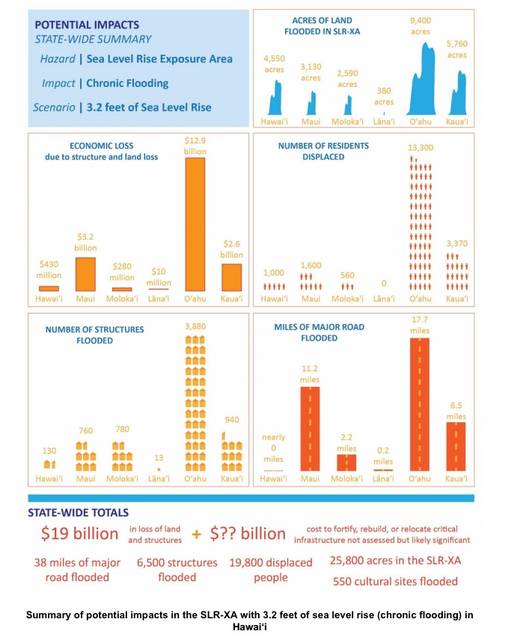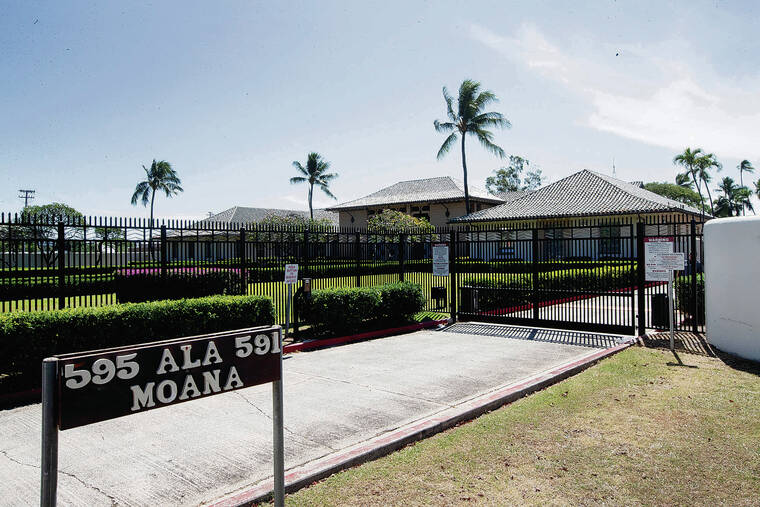PUHI — Threats to species, shorelines and structures, as well as opportunities for innovation were all on the table as the Earth Matters public lecture series opened Tuesday with a panel discussion on climate change and conservation.
About 100 people attended the gathering at Kauai Community College, led by seven experts in fields and industries on Kauai connected to climate change.
“We see the fingerprints of climate change everywhere,” said Chipper Wichman, head of National Tropical Botanical Garden, which is hosting the lecture series alongside KCC.
He continued: “Let’s not stick our head in the sand. Get out there in front of it and do the very best we can to make our island resilient.”
Shorelines and sea level rise
Experts predict that Hawaii will experience a 3.2-foot rise in sea levels by the year 2100. Extreme predictions point to a 10-foot rise.
With that three-foot sea level rise, Hawaii is set to lose more than 25,800 acres of land statewide, according to the recently released Hawaii Sea Level Rise Vulnerability and Adaptation report.
The report also estimates at least a $19 billion bill from the flooding of 38 major roads and 6,500 structures, as well as an estimated nearly 20,000 people displaced.
And while these predictions point to future events, experts said shoreline changes are happening now — both as a result of climate change and other factors, such as direct human activity.
Sea walls and sandbags were highlighted as human activities that are impacting shorelines and interrupting natural processes. According to the sea level report, Kauai has already lost almost four miles of beaches due to erosion fronting seawalls.
“The impact of humans is much more of an immediate change than long term, global climate change, however we’re making these human changes while in the background, sea level continues to rise,” said Chuck Blay, sedimentary geologist and panel member.
Together, with Ruby Pap, Coastal Land Use Extension Agent for the University of Hawaii Sea Grant Program, Blay predicts a mauka movement of the beaches as sea level rises.
On Kauai, more than 900 structures would be chronically flooded by 3.2 feet of sea level rise, according to the Sea Rise Vulnerability and Adaptation report, and structures next to the shoreline could be impacted in as little as 30 years.
The report says some of the areas that would be exposed to extreme chronic flooding are Ke’e Beach, Kilauea, Polihale Beach, and Nawiliwili Harbor.
“You look at it and think, how are we going to adjust to all of this? You start wondering, how can Hawaii afford this,” Blay said.
Flora and Fauna
While sea level rise is affecting Hawaii’s shorelines, the reported rise in global temperatures is threatening the plants and animals across the archipelago as well — many of them endemic to specific areas on specific islands, and many of them endangered.
“It’s been shown that narrowly endemic species everywhere are particularly vulnerable to climate change,” said Maggie Sporck-Koehler, botanist with the Department of Land and Natural Resources Division of Forestry and Wildlife.
With the warming and drying of Earth in the coming years, species’ ability to be healthy in the natural habitat will be challenged by things like fire, the introduction of invasive species, and erosion.
“At the state, we’re talking already about what actions are needed to continue doing conservation work in light of climate change threats,” Sporck-Koehler said. “We’re looking at predicted impacts to provide guidance for our management and to incorporate some of these actions into our recovery plans for certain species.”
The goal will be to find which plant species are vulnerable and “take action before it’s too late,” she said.
Shrinking habitat is a problem for the forest birds, too, which have shrunk from 13 species statewide to eight species, six of which are endemic only to Kauai.
Four of Kauai’s endemic forest birds are honeycreepers, one is a thrush, and one species is a flycatcher, and their territory used to encompass the entire island. It’s diminished due to invasive species, forest composition changes, and clearing for agriculture and urban development.
With the rise in temperatures and the arrival of mosquitoes and their vectoring of avian malaria and avian pox, the forest birds have been corralled to the Alaka’i Plateau.
“Already on Kauai, we’re faced with very little mosquito-free habitat,” said Lisa “Cali” Crampton, project leader with the Kauai Forest Bird Recovery Project. “There’s no more cold elevation areas for the birds to move into.”
Increasing temperatures in the ocean are having an effect on life as well, according to Katie Nalasere, with Hawaii’s Department of Aquatic Resources.
“A one or two degree difference to a coral is pushing their limits, when the polyps get stressed they release the algae they eat and they lose food, they starve,” Nalasere said. “If that is persistent, it can lead to mass mortality.”
To protect the reefs, the state is looking at expanding the network of marine protected areas, find ways to minimize land-based pollution, and create programs to protect herbivores, which maintain algae balance on the reefs.
Problems and solutions
Ben Sullivan, Kauai County’s energy and sustainability coordinator, said he’s been working statewide to find ways to mitigate the impacts of climate change throughout Hawaii and on Kauai.
“We’re starting to see the challenges we face. It’s a massive challenge and there are massive opportunities,” Sullivan said.
He pointed to the incorporation of solar into Kauai’s power grid as one of the opportunities that climate change has brought to the forefront, and Jan Tenbruggencate chimed in as a member of the Kauai Island Utility Cooperative’s board.
“KIUC, as many of you know, is the worst player in the production of greenhouse gases. The good news is we know that and are trying to change that as quickly as we can,” he said.
A strategic plan was developed in 2008 to address the situation. In that plan, KIUC decided to set the goal of cutting fossil fuel usage by 50 percent and switching to renewable by 2023.
“We’re going to reach that 50 percent number this year, five years early and we’ve reestablished our strategic plan at 70 percent by 2030 and the way we’re doing it is by saying we want to do it,” Tenbruggencate said. “Once you have a strategic goal established when technology catches up you can act immediately.”
The big question on the panel table Tuesday night was: can we adapt? The answer was: we have to.
“The Earth will still be here,” Pap said. “We’ll have to adjust. We’ll have to move back.”
Sporck-Koehler said she believes humans will adapt to future conditions, but she wonders if the predicted world is one anyone would want to live in.
“We need to do more than we’re doing,” Tenbruggencate said. “The people who are alive 100 years from now will benefit from what we’re doing now. Think about what we’re leaving them.”






While parts of the world are ironically freezing over this northern winter; it’s encouraging that climate change (translated as dirty rotten stinking filthy toxic pollution) is being addressed.
What befuddles the average normal thinking mind is that the Ag toxic poisonous petrochemical pesticide insecticide use is given a FREE-GO PASS ticket polluting the land sea air water and people.
Is that the left hands don’t know the rights?
Mahalo,
Charlie
Who writes your headlines? An ESL student?
ML
Climate Change? Seriously? The west side beaches have been bigger in the past few years than they ever have been.
Yawn – What a colossal waste of time and money!
Wow! sounds good!
With absolutely no evidence other than computer models and conjecture these people are waving the “sky is falling” and fear-mongering flags. How egotistic to think that we petty humans can alter the vastly powerful geologic processes.
Do a little reading. Changing climates, sea levels and glaciers have been a part of the earth for billions of years. Nothing we do can change that, one way or another.
Human beings are only capable of adapting, not altering. Enough already!
RG DeSoto
Kudos to KIUC for their commitment to greatly reducing the use of fossil fuels for generating electricity.
Every little bit helps, for sure, but I’m afraid that the amount of energy we’ve already added to the atmosphere will have a very unpleasant cumulative effect on our environment within this century.
“With absolutely no evidence other than computer models…”
Computer models are kinda key… #Science #Math #WakeUp